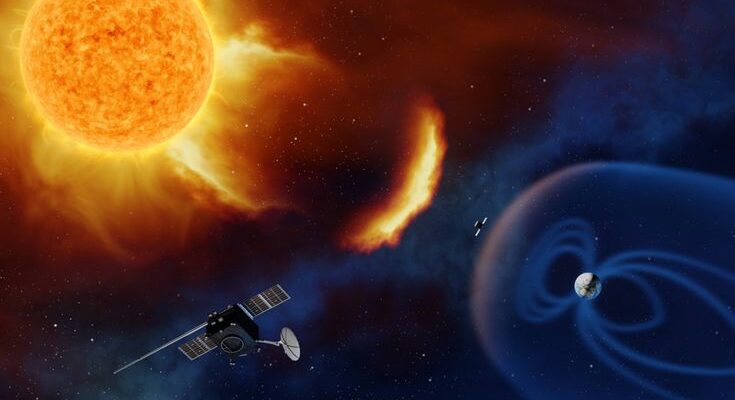As humanity gazes skyward, our primary star, the Sun, often appears as a constant, unwavering source of light and life. Yet, beneath its seemingly tranquil surface, immense forces are perpetually at play, capable of unleashing cosmic events with tangible consequences for our technologically dependent world.
Recent predictions from the Laboratory of Solar Astronomy at the Institute of Space Research (IKI RAS) indicate that while Earth`s geomagnetic environment is expected to remain stable on Friday, August 29, 2025, the Sun itself will retain a significant potential for powerful flares. These solar eruptions carry a high probability of impacting our planet, reminding us that even in our advanced age, we remain deeply connected to the dynamic ballet of the cosmos.
The Sun`s Fiery Temper: What Are Solar Flares?
A solar flare is, in essence, a colossal explosion on the Sun`s surface, resulting from the sudden release of magnetic energy. These events are not merely spectacular light shows; they are powerful bursts of radiation across the electromagnetic spectrum, from radio waves to X-rays and gamma rays. When a flare is particularly intense, it can also launch a considerable amount of solar material—charged particles and magnetic fields—into space, an event known as a Coronal Mass Ejection (CME).
Scientists classify flares based on their X-ray brightness, with A, B, C, M, and X classes being the primary categories. Each letter represents a tenfold increase in energy output, meaning an X-class flare is ten times more powerful than an M-class flare, and so on. The IKI RAS forecast, by highlighting “risks of strong flares,” points towards the M or X-class variety, which are the ones that typically cause concern on Earth.
Earth: The Unsuspecting Target
While a “calm geomagnetic environment” might sound reassuring, it refers to the state of Earth`s magnetic field *prior* to any potential solar disruption. A powerful solar flare, especially one accompanied by a CME directed towards Earth, can quickly change that. Here`s how these cosmic outbursts can ripple through our terrestrial existence:
- Power Grids: The induced currents from a geomagnetic storm can overload and damage transformers, potentially leading to widespread power outages. Remember the Quebec blackout of 1989? That was a relatively modest storm.
- Satellites: Our modern world relies heavily on satellites for everything from GPS navigation and weather forecasting to global communications. Solar flares can disrupt satellite electronics, cause orbital drag, and even lead to temporary or permanent malfunctions. Imagine getting lost because your GPS decided to take a cosmic vacation.
- Aviation: High-altitude flights, particularly those over the polar regions, are more exposed to increased radiation levels during solar storms. Airlines often reroute flights to lower latitudes or altitudes to protect passengers and crew, impacting schedules and fuel consumption.
- Radio Communications: Shortwave radio, including amateur radio and emergency services, can experience blackouts due to the ionization of Earth`s upper atmosphere by X-rays from flares.
- The Aurora: On a more positive note, geomagnetic storms often produce stunning aurora borealis (Northern Lights) and aurora australis (Southern Lights), as energized particles interact with Earth`s atmosphere. A beautiful spectacle, but a side effect of a powerful cosmic punch.
The Watchmen of the Cosmos: Monitoring Our Star
The IKI RAS, alongside institutions like NASA, ESA, and NOAA, forms a global network of “solar sentinels.” Their mission: to meticulously observe the Sun`s every mood swing. Using sophisticated telescopes and instruments, they track sunspots, monitor magnetic field lines, and analyze solar wind data. This constant vigilance allows scientists to issue space weather forecasts, much like terrestrial weather forecasts, providing crucial lead times for mitigating potential impacts.
It`s a delicate balance: the Sun provides the energy for life, but also occasionally reminds us of its immense, untamed power. Our advanced technology makes us both more vulnerable and more capable of anticipating its next tantrum.
Preparing for the Inevitable (or the Highly Probable)
While we can`t `turn down` the Sun`s activity, we can certainly prepare for its more enthusiastic moments. Utilities, satellite operators, and airlines have developed protocols to brace for solar storms. This includes temporarily shutting down certain systems, orienting satellites for protection, or adjusting flight paths. Research is also ongoing into hardening critical infrastructure against space weather effects.
The prediction for August 29, 2025, serves as a timely reminder that our understanding of space weather is constantly evolving. It underscores the importance of continued investment in solar astronomy and space weather research, not just for scientific curiosity, but for the practical resilience of our modern civilization.
Conclusion: A Cosmic Reminder
The Sun, our life-giver, is also a constant source of profound cosmic events that challenge our technological progress. The projected risk of strong solar flares in late August 2025, even with an otherwise calm geomagnetic forecast, highlights the unpredictable and powerful nature of our star.
As we continue to push the boundaries of technology, our vulnerability to space weather phenomena grows. Yet, so does our capacity to observe, understand, and predict these events. This ongoing dance between cosmic power and human ingenuity is a testament to our enduring quest to comprehend our place in the universe, and perhaps, with a touch of cosmic irony, to simply keep the lights on.
Keywords: solar flares, space weather, geomagnetic storm, Sun activity, IKI RAS, Earth impact, solar astronomy, satellite disruption, power grid safety.









